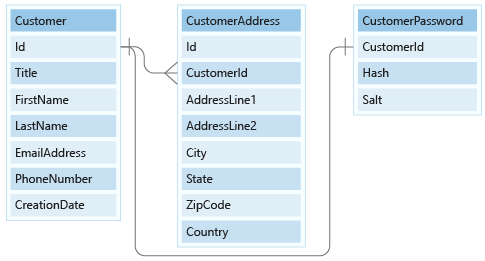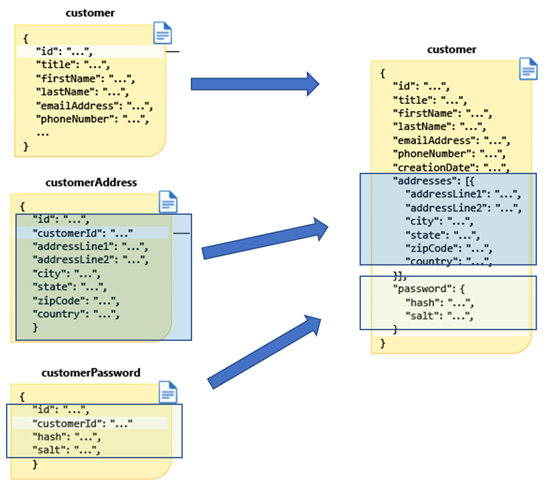Identify access patterns for your app
When you're designing a data model for a NoSQL database, the objective is to ensure that operations on data are done in the fewest requests. To do this, you need to understand the relationships between the data and how data will be accessed by the application. These access patterns are important because they, along with the relationships, will determine how the properties of the various entities are grouped together and stored in documents within containers in Azure Cosmos DB for NoSQL.
In Azure Cosmos DB for NoSQL, documents are called items and containers are often synonymously referred to as collections.
Identify access patterns for customer entities
Let's start with the customer entities in our e-commerce database. The following diagram shows three entities and the relationships between them. The three entities are Customer, CustomerAddress, and CustomerPassword. The Customer entity has a 1:Many relationship to CustomerAddress. Customer has a 1:1 relationship to CustomerPassword.

In our application, we'll perform three operations on the customer entities:
- Create a customer: When a new user first visits the e-commerce site, a new customer will be created.
- Update a customer: When an existing user updates their profile information, their customer record will be updated.
- Retrieve a customer: When an existing user visits the site, they'll sign in with their password. During that same session, they'll need to access other customer data (such as address) to purchase new items.
For each of these operations, we need all this data at the same time. If they were modeled as separate documents, it would require multiple round trips to the server to create, update, and retrieve the customer data. This is inefficient.
Model customer entities
Azure Cosmos DB stores data as JSON, so we can model the 1:Many relationship between Customer and CustomerAddress and embed the customer address data as an array. For the 1:1 relationship between Customer and CustomerPassword, we can embed that as an object in our new single customer document. Then the e-commerce application can create, edit, or retrieve customer data in a single request.
The following diagram shows what our customer entity looks like.
